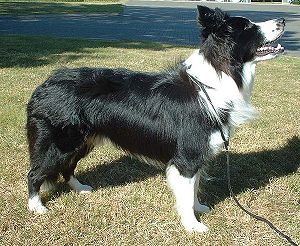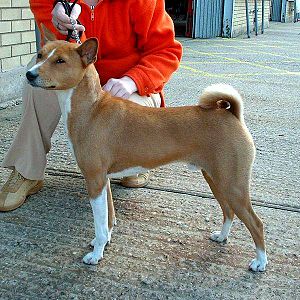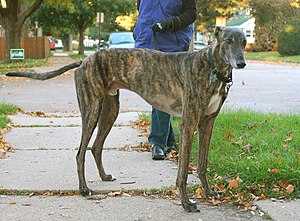Adventist Youth Honors Answer Book/Nature/Dogs
| Dogs | ||
|---|---|---|
| Nature General Conference |
Skill Level 1 | 
|
| Year of Introduction: 1950 | ||
|
The Dogs Honor is a core component of the Naturalist Master Award . |
|
The Dogs Honor is an optional component of the Zoology Master Award
(available only in the South Pacific Division) |
1. Give the scientific name of the dog family.[edit | edit source]
The scientific name of the dog family is Canidae, or Canine.
2. Name five distinctive characteristics of the dog family.[edit | edit source]
- Canines have 42 teeth.
- They walk on their toes.
- They have four claws on their hind feet, and five on the front.
- They have two coats - an outer coat of coarse hair, and an inner coat of fine hair.
- They have a keen sense of smell.
- They have excellent hearing due to ear flaps called leathers.
- They can see colors but not as clearly as we can.
3. Identify from pictures or personal observation five wild members of the dog family.[edit | edit source]
We present here several species of fox, but as the instructor, you should feel free to present them as one "member." This is also true of the jackal.
African Wild Dog[edit | edit source]
Dhole[edit | edit source]
The dhole or Asiatic Wild Dog (Cuon alpinus) is about the size of a border collie (12–18 kg), but looks quite different. The coat is usually a rusty red colour, but varies regionally from sandy yellow to dark grey. See our dhole map page for details of regional colour variation (frame-compliant browsers only). Usually it has a black bushy tail and white patches on its chest, paws and belly. Its ears are rounded, and its hooded amber eyes portray an intelligent nature.
Within the canid family the dhole is something of an enigma. It doesn't fit neatly into any of the sub-families (i.e. the foxes or wolf-like dogs) and is classified in a genus of its own - Cuon. Among its unusual features is a strange whistle call which it uses to re-assemble the pack when animals become separated in dense forest. The dhole also has more teets than most other dogs and has a shorter jaw with one less molar on each side of its lower jaw.t
Gray Fox[edit | edit source]
| Urocyon cinereoargenteus (Grey Fox) | |
|---|---|
|
Description: The gray fox is small and has a pepper brown back, tawny sides, neck and legs, a white belly, and a black stripe along its back and tail. Another black stripe crosses its face from the nose to the eye and continuing to the side of the head. Standing about 12-16 inches at the shoulders, weighing up to 16 pounds and having an overall body length of up to 47 inches, the gray fox is an agile canid able to scurry up and down trees with relative ease.
|
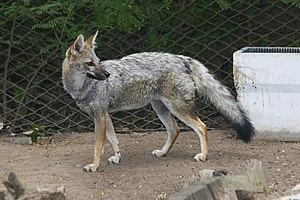 |
Arctic Fox[edit | edit source]
| Alopex lagopus (Arctic Fox) | |
|---|---|
|
Description: The Arctic fox, also known as the polar fox, is a small fox native to cold Arctic regions of the Northern Hemisphere. Arctic foxes will eat pretty much anything. Their prey includes voles, lemmings, hares, ground squirrels, and bird eggs. Foxes living on the coast also eat shellfish, sea urchins, dead seals and fish, beached whales, and nesting seabirds. In winter when food is scarce, they may follow a polar bear and after the bear makes a kill, eats and leaves, they will steal what ever scraps of meat are left. In winter, their light coat protects them from predators, esp. polar bears, by blending in to the white snow.
|
 |
Pale Fox[edit | edit source]
| Vulpes pallida (Pale Fox) | |
|---|---|
|
Description: The Pale Fox is a species of fox which inhabits the Sahel from Senegal in the west to Sudan in the east. It is widespread throughout the Sahel but its environmental status is described as "data deficient" due to lack of intensified study of the pale fox in the wild. The pale fox is long-bodied with relatively short legs and a narrow muzzle. Its ears are long and rounded at the tip. Its tail is bushy and black-tipped. The upperpart of its body has a pale sandy color, while the underpart is whitish. A dark ring surrounds the fox's eyes.
|
|
Cape Fox[edit | edit source]
| Vulpes chama (Cape Fox) | |
|---|---|
|
Description: The Cape Fox has black or silver gray fur with flanks and underside in light yellow. The tip of its tail is always black. The Cape Fox is found in Southern Africa from Zimbabwe to Angola. It prefers the open savanna and semi-arid regions in southwestern Africa, from Southern Zimbabwe to the Cape province.
|
 |
Red Fox[edit | edit source]
| Vulpes vulpes (Red Fox) | |
|---|---|
|
Description: The Red Fox is the most familiar of the foxes. In Britain and Ireland, where there are no longer any other native wild canids, it is referred to simply as the "Fox". It has the widest range not just of any fox but of any terrestrial carnivore. As its name suggests, its fur is predominantly reddish-brown
|
 |
Gray Wolf[edit | edit source]
| Canis lupus (Gray Wolf) | |
|---|---|
|
Description: The Gray Wolf, also known as Timber Wolf or Wolf, shares a common ancestry with the domestic dog (Canis lupus familiaris), as evidenced by DNA sequencing and genetic drift studies. Gray wolves were once abundant and distributed over much of North America, Eurasia, and the Middle East. Today, for a variety of human-related reasons including widespread habitat destruction and excessive hunting, wolves inhabit only a very limited portion of their former range. Though listed as a species of least concern for extinction worldwide, for some regions including the Continental United States, the species is listed as endangered or threatened.
|
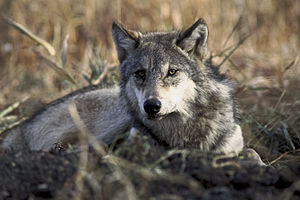 |
Coyote[edit | edit source]
| Canis latrans (Coyote) | |
|---|---|
|
Description: Coyotes are native to North America and are found from Alaska, U.S. to as far south as Panama. European explorers first encountered these canines during their travels in the American Southwest. They may occasionally assemble in small packs, but naturally hunt alone. Coyotes live an average of about 6 to 10 years.
|
 |
Dingo[edit | edit source]
| Canis lupus dingo (Dingo) | |
|---|---|
|
Description: The dingo is a type of wild dog, probably descended from the Indian Wolf (Canis lupus pallipes). It is commonly described as an Australian wild dog, but is not restricted to Australia. Modern dingoes are found throughout Southeast Asia, mostly in small pockets of remaining natural forest, and in mainland Australia, particularly in the north.
|
 |
Golden Jackal[edit | edit source]
| Canis aureus (Golden Jackal) | |
|---|---|
|
Description: The Golden Jackal has golden reddish-yellow fur with a white mark on the throat, but the color can vary with age, region and season; in winter the coat darkens. Typical body length is 70-85 cm and height is 40 cm. It can weigh as little as 8 kg and much as 10 kg. Males tend to be larger than the females.
|
 |
Side-striped Jackal[edit | edit source]
| Canis adustus (Side-striped Jackal) | |
|---|---|
|
Description: Side-striped jackal is a greyish brown to tan with a white stripe from the front legs to the hips and has a dark tail that has a white tip. Side-striped jackal can weigh from 14 to 30 lb. Males tend to be larger than the females. They are social within small family groups, communciating via yips, "screams" and a soft owl like hooting call. They are nocturnal, and rarely active during the day.
|
 |
Black-backed Jackal[edit | edit source]
| Canis mesomelas (Black-backed Jackal) | |
|---|---|
|
Description: The Black-backed jackal (Canis mesomelas) is an African canine with a fox-like appearance, tan fur, and a thick stripe of black and silver running down its back. They weigh anywhere from 15 to 30 pounds and are 15 to 30 centimeters at the shoulder. Males are usually larger than females.
|
 |
4. Identify from pictures or personal observation 25 different breeds of dogs.[edit | edit source]
The South Pacific Division has revised this requirement and reduced to 15 different breeds of dogs.
When teaching this honour point out the 7 different categories of dogs as viewed by a kennel club (some kennel clubs in other countries may have different categories) : Toy, Terrier, Gundog, Hound, Working, Utility, Non Sporting. See if they can identify dogs from each of these to make the honour more relevant.
Several dog breeds are presented here, but this is by no means an exhaustive list. No toy dog breeds are presented here as they can be found in requirement 9.
Afghan Hound[edit | edit source]
German Shepherd[edit | edit source]
Golden Retriever[edit | edit source]
Siberian Husky[edit | edit source]
Beagle[edit | edit source]
Border Collie[edit | edit source]
Rough Collie[edit | edit source]
Smooth Collie[edit | edit source]
Boxer[edit | edit source]
Bulldog[edit | edit source]
Dalmatian[edit | edit source]
Saluki[edit | edit source]
Saint Bernard[edit | edit source]
Great Dane[edit | edit source]
Basenji[edit | edit source]
Bernese Mountain dog[edit | edit source]
Borzoi[edit | edit source]
Whippet[edit | edit source]
Australian Shepherd[edit | edit source]
Hungarian Vizsla[edit | edit source]
Dachshund[edit | edit source]
Greyhound[edit | edit source]
Harrier[edit | edit source]
Labrador Retriever[edit | edit source]
5. Name five contributions the dog family has made to man.[edit | edit source]
- Companion animals.
- Seeing-eye dogs help the blind gain independence.
- Watchdogs protect property (and their owners).
- Hunting dogs help retrieve and flush out game.
- Sled dogs are used as transportation.
- Dogs herd cattle, sheep and other livestock.
- They can be used to follow a scent trail, whether to catch a criminal or find a missing person.
- They can detect explosives.
- They are used to search through earthquake rubble for victims.
6. Give the name of the smallest and largest breed of dog.[edit | edit source]
The smallest breed of dog is the Chihuahua. Many breeds can claim to be the "largest" depending on how "largest" is defined. The tallest is the Irish Wolfhound, but it is outweighed by the Mastiff, the Great Dane, and the Saint Bernard. The heaviest of these is the Saint Bernard.
7. Write or describe orally the value to man of the following dogs[edit | edit source]
a. Seeing-eye[edit | edit source]
Seeing-eye dogs, or guide dogs are assistance dogs trained to lead blind or visually impaired people around obstacles. The human half of the guide dog team does the directing, based upon skills acquired through previous mobility training. The handler might be likened to an aircraft's navigator, who must know how to get from one place to another, and the dog is the pilot, who gets them there safely.
Despite regulations or rules that deny access to animals in restaurants and other public places, in many countries, guide dogs and other types of assistance dogs are protected by law, and therefore may accompany their handlers most places that are open to the public.
b. Saint Bernard[edit | edit source]
The ancestors of the St. Bernard are the herding dogs of Swiss farmers as well as hunting dogs and watchdogs. Their history has also been connected with the hospice at the Great St. Bernard Pass.
The most famous Saint Bernard to save people at the pass was Barry, who reportedly saved somewhere between 40 and 100 lives. There is a monument to Barry in the Cimetière des Chiens, and his body was preserved in the Natural History Museum in Berne, Switzerland.
The classic St. Bernard looked very different from the St. Bernard of today, as an avalanche killed off many of the dogs used for its breeding. Breeders crossed the remaining dogs with other dogs, but in the process they lost much of their use as rescue dogs.
c. Shepherd[edit | edit source]
A shepherd dog is a type of domestic dog whose original purpose was to herd or guard sheep, though they have been used for other types of livestock as well. A herding dog will keep a herd or flock of animals together and help a farmer direct them from one place to another (such as from a sheep fold to a pasture). They will also guard livestock from predators.
d. Collie[edit | edit source]
Collies are a type of shepherd dog. Some say the Border Collie is the most intelligent breed of dog.
e. Eskimo[edit | edit source]
The Eskimo Dog, otherwise known as the Qimmiq (Inuit for "dog"), or what is considered to be the more culturally sensitive Canadian Inuit Dog, is the largest breed of Arctic dog commonly found pulling sleds for their Inuit counterparts. However, as snowmobiles tend to be faster and more efficient, the Eskimo Dog is now a rare breed.
8. Write or tell what special contribution dogs have made to man in wartime.[edit | edit source]
Dogs have been used by the military since ancient times. They have been used:
- To sniff out landmines
- To carry messages
- As sentries
- As scouts to detect booby-traps
- As attack dogs in battle
9. Identify from pictures or personal observation five dogs that are classed as "toy" dogs.[edit | edit source]
| Maltese | |
|---|---|
|
Description: The Maltese is covered from head to foot with a mantle of long, silky, white hair. Adult Maltese range from roughly 3 to 10 lb (1.4 to 4.5 kg)
|

|
10. What is the only dog that has a wholly blue or black tongue?[edit | edit source]
The Chow chow.
11. Which is the fastest-running dog?[edit | edit source]
The matter of which dog breed is the fastest is a matter of dispute. Some say the Saluki, and others say the Greyhound.
12. Which member of the "toy" dogs has become the most popular?[edit | edit source]
The Yorkshire Terrier [1] is currently the most popular breed of toy dog, and the third most popular dog breed overall (nearly overtaking the Golden Retriever for second place in 2005).
The answer to this question will vary country to country and change in different era's. Labrador Retrievers are still New Zealand's most popular dogs according to 2006 registrations with the NZ Kennel Club.10th Chihuahuas (long coat) (no change from 2005, was 15th in 2004). The Chihuahua is the most popular Toy Dog in New Zealand as of 2005. Different areas of a country may have a more popular breed of dog. So you need to expect a wide variation in answers to this question. Personally at present in my part of the country (NZ) the Bichon Frise.
13. What dog has been especially helpful in tracking criminals?[edit | edit source]
The Bloodhound has been used extensively to track the scent not only of criminals, but also of lost children and even adults suffering from dementia.
The Australian Police use the German Shepherd for tracking criminals and lost people. Many years ago they did use Bloodhounds but found them too difficult to use tracking a criminal as this breed is a large dog and the handler has to lift the dog over fences so they do not use them anymore.
The New Zealand Police Dog teams and Search and Rescue teams use the German Shepherd for general roles but use the Labrador Retrievers for more specialist roles.
The United Kingdom used to use the Bloodhound for tracking criminals. Their size was certainly an effective deterrent. But in practice the Bloodhound when it caught up with the offender rushed up knocked him over and wanted to play. They do not grab with the jaw of stand over the offender to subdue him. These dogs are not good around young children unsupervised. They do not realize their own size and strength and usually end up hurting or scaring the child. The Police in the UK no longer use this breed they have changed to mainly using the German Shepherd.
14. Write or tell a dog story.[edit | edit source]
As the instructor it will be up to you to moderate the story-telling event, or to encourage the Pathfinders to write their essays. The more extroverted Pathfinders in your group may prefer to tell the stories, while the introverted ones may prefer to write theirs. Allow each Pathfinder to choose which method they will use.
References[edit | edit source]
- http://www.pathfindersonline.org/pdf/resources/honor_dogs_answers.pdf
- Wikipedia articles were borrowed for virtually every dog breed and canine species listed here. Also, the article on War dogs was consulted, but the material was summarized rather than copied verbatim.
Notes[edit | edit source]
- Book:Adventist Youth Honors Answer Book/Honors
- Book:Adventist Youth Honors Answer Book
- Book:Adventist Youth Honors Answer Book/Skill Level 1
- Book:Adventist Youth Honors Answer Book/Honors Introduced in 1950
- Book:Adventist Youth Honors Answer Book/Nature
- Book:Adventist Youth Honors Answer Book/General Conference
- Book:Adventist Youth Honors Answer Book/Naturalist Master Award/Core
- Book:Adventist Youth Honors Answer Book/Zoology Master Award/Options
- Book:Adventist Youth Honors Answer Book/Completed Honors





